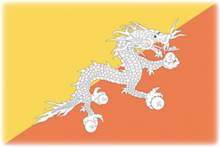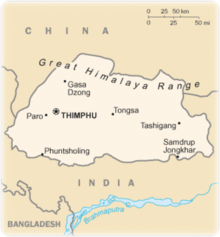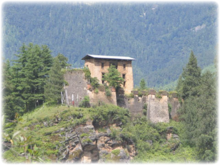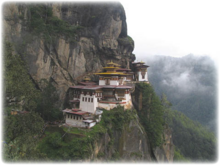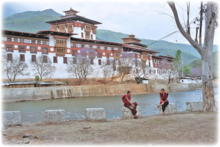
General Information
| Languages : | Dzongkha, English |
| Currency : | ngultrum (BTN); Indian rupee (INR) |
| Time Zone : | Bhutan Time (EST +11hrs) |
| Capital City : | Thimphu |
| Population : | 2.3 Million |
| Government : | Absolute Monarchy |
| Total Area : | 18,146 mi² |
| Climate : | Varies; tropical in southern plains; cool winters and hot summers in central valleys; severe winters and cool summers in Himalayas |
| National Holidays: | National Day (Ugyen WANGCHUCK became first hereditary king), 17 December |
| Additional Info: | The local name for the country is Druk Yul. It is also called Druk Tsendhen (land of the thunder dragon), because the thunder there is said to be the sound of roaring dragons. The landscape ranges from subtropical plains in the south to the Himalayan heights in the north, with some peaks exceeding seven thousand meters |
Destination Activities
Activity Details
Trekking
Trekking in Bhutan is most recommended from late-September to late-November when skies are generally clear and the high mountain peaks rise to a vivid blue sky. March-May is also recommended as a preferred time to visit for trekking.
There are various treks to explore in one or several trips to Bhutan, including: Bumthang Valley, Chomolhari, Druk Path, Laya Village, and The Snowman Trek.
Bumthang is one of the 20 districts comprising Bhutan. It is the most historic, if the number of ancient temples and sacred sites is counted. Bumthang consists of the four mountain valleys of Ura, Chumey, Tang and Choekhor. Trek features of this area include local rural life, the Bumthang valley, and the spectacular Himalayan scenery.
Chomolhari, sometimes known as "the bride of Kangchenjunga", is a mountain in the Himalayas, straddling the border between Yadong County of Tibet and the Paro district of Bhutan. Many recommend starting your trek at Drugyel Dzong; and then pass through scattered villages and farmland, into a deep and richly forested valley, which leads to a high alpine pastureland where yak herders graze their animals. Camp high beside a clear lake, beneath the 10,000ft high East Face of Chomolhari.
The peculiar high ridges of Druk Path that remain windy most of the time of the year, classic mountains with charming and enchanting bush of rhododendron, and historically preserved reminiscence of forts are the sights to watch. A short four-day trek runs here, which leads from Thimpu to Paro, or reverse, crossing the chain of mountains that separates the two valleys. Although there is little settlement on this route, there are wonderful lakes teeming with fish and the area is famous for its impressive rhododendron forests, which bloom in May.
The long-established route from Chomolhari across to Laya will ranks as one of Bhutan's finest treks. This trekking route offers a great variety of conditions, from scenic farmland and forest to alpine pastureland and elevated passes. There are numerous impressive campsites, beneath some of Bhutan's most inspiring peaks, of which the most notable are Chomolhari and Jitchu Drake, also a feature of this trekking route. There are numerous secluded dzongs and dotted settlements, including the village of Laya.
The Snowman Trek, probably one of the hardest high altitude treks, provides an incredible experience for anyone who ready for a challenge. Traveling into the Lunana district, the Snowman trek is named for the six mountains over 23,100ft which the trek passes beneath. Crossing nine passes over 15,850ft makes this not only one of the highest altitude treks, but also one of the most challenging. The trek starts in Drukgyel Dzong and heads towards Jhomolhari at 24,135ft, the third highest peak in Bhutan. Follow the Paro Chhu river valley up into the mountains, pass Buddhist monasteries and small villages and observe a land that has remained unchanged for hundreds of years. Here, you can trek past blue pine, juniper and rhododendron forests, and look for the famous Himalayan blue sheep, bearded vultures and Himalayan griffins flying overhead.
Many companies provide toured expeditions of all these areas including guided treks.
Cultural Activities
The local name for Bhutan is Druk Yul. It is also called Druk Tsendhen (land of the thunder dragon), because the thunder is said to be the sound of roaring dragons. Bhutan is one of the most isolated and least developed nations in the world. This is a country where Buddhism permeates all strands of cultural, ethical, and secular life.
First, when you fly into Paro, Bhutan, sop to enjoy fantastic views of eight of the ten tallest peaks in the world, including Mount Everest, Kanchanjunga, and Mount Makalu. Staying around Paro, you can see the huge turning prayer wheels in temples dating back to the 7th century. Observe and go into the vast courtyards of impressive fortress-monasteries (dzongs) and watch the red-robed monks of all ages at prayer and at play. Local delicacies that should be sampled include red rice, fern shoots, matsutake and other mushrooms, delicious meat or vegetable dumplings and exotic fruits from the lower altitudes. Taste the spicy Bhutanese breakfast of chillies and cheese (but beware it is spicy!) If you enjoy shopping for local handicrafts and arts, there are many shops in Paro, and the capital city of Thimphu.
In the Paro Vallery, one can find Taktshang, or Tiger's Nest, the most famous monastery in Bhutan. It hangs on a cliff at 10,200 ft, some 2,300ft above the bottom of Paro valley. The legend being that Padmasambhava (Guru Rinpoche) flew there on the back of a tiger. The monastery includes seven temples which can all be visited. The monastery suffered several blazes and is a recent restoration. Climbing to the monastery is on foot or mule.
At the northern edge of Thimphu, the capital of Bhutan and the name of the surrounding valley and district, you will find Tashichoedzong, the fortress monastery built in the 17th century; it has been the seat of Bhutan's government since 1952. Tashichoedzong hosts a colorful masked-dance festival (tsechhu) at the end of summer, which is popular with tourists. A new Tsechhu ground is said to be constructed that can take in the capacity of both tourists and the locals as well.
Punakha is the administrative center of Punakha dzongkhag, one of the 20 districts of Bhutan. Punakha was the capital of Bhutan and the seat of government until 1955, when the capital was moved to Thimphu. In this region, you can visit Chimi Lhakhang, the temple of Drukpa Kinley, the Divine Madman, an eccentric character who played a significant role in Bhutanese religious and cultural history. Sited on the top of a gently rolling hill, the Lhakhang is approached by taking a pleasant walk through a small village, across the neatly terraced rice fields and then up onto the expansive hilltop. Couples who wish to receive a fertility blessing should visit this temple.
Photography
If you have adventure-travel related experience in this region and would like to add content to this page, please contact us to learn how.
